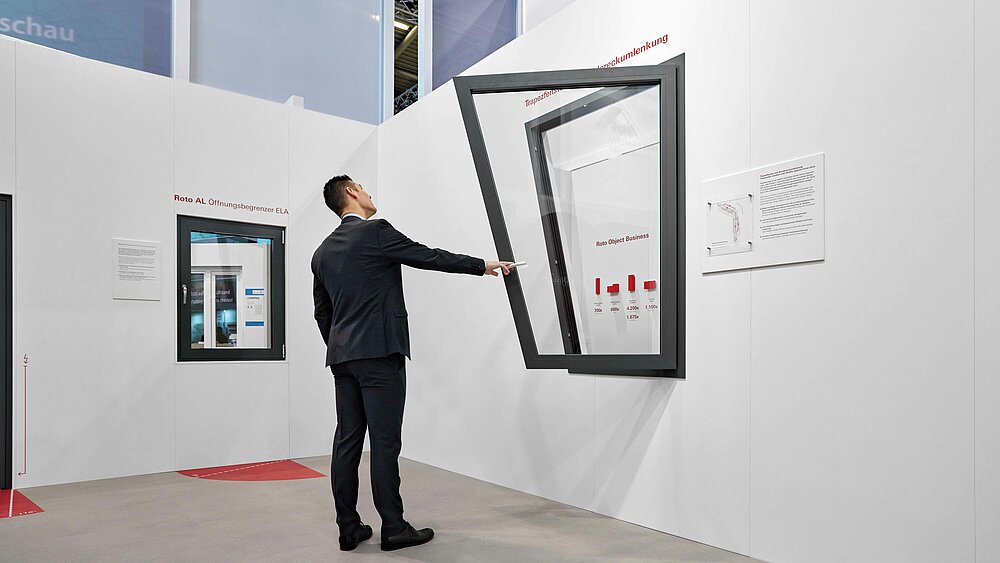
Full functionality and tight sealing for pitched windows
Roto has developed a flexible special corner drive for aluminium pitched windows with acute or obtuse angles. This can be combined with Roto AL (surface-mounted hinge side) or Roto AL Designo (concealed hinge side) Tilt&Turn hardware. The Roto Object Business organises project-specific system tests.
Whether an architect-designed home or office building – multipart window / facade elements often feature in a customized building design. In many cases, the plans call for pitched elements as well as rectangular windows. If these elements are designed as an opening element rather than fixed glazing, this gives rise to the question: which hardware tightly closes windows with obtuse and acute angles while ensuring the usual operating convenience?

Tightly sealed as standard
The functional safety and sealing of a pitched window must be in no way inferior to that of a rectangular window. At the same time, it’s in the manufacturer’s interest to produce pitched windows with familiar components and processes. Roto has now developed a solution for aluminium windows which makes it easier to economically produce tightly sealed pitched windows.
Easy to install at any profile depth
The new flexible corner drive for acute and obtuse angles is easy to push into the profile, where it is fixed in place with four piercing screws. It is designed to be used even in very slimline profiles. Like standard hardware, combining the new components with the Roto AL Tilt&Turn system, or Roto AL Designo for pitched windows, is proven to achieve tight sealing and guarantees functionality without limits: even sashes at an angle can be opened by turning or tilting. Project-specific tests with a trapezoidal window from Metra Building, which Roto showcased at BAU in Munich, provided clear proof of this.
Locking points can be positioned all around the outside
Since the special corner drive is adapted to the shape of the window, locking points can be positioned all around the outside, just like on a standard window. This creates tight sealing and also makes an RC 2-compatible version possible. Roto tests pitch window systems for customers at one of the two International Technology Centres (ITC) at the factory sites of Leinfelden-Echterdingen (Germany) and Kalsdorf (Austria). Both accredited test laboratories can also provide support to Roto customers at short notice.

Hidden technology
When planning aluminium windows, most discerning designers want to avoid using visible hinges or functional elements on the window. With the Roto AL Designo concealed hardware in conjunction with the new special corner drive, every window manufacturer can offer a suitable solution with support from Roto. A window system with the new special corner drive and sash weights of up to 180 kg, a width of 735 mm to 1220 mm and a height of 1000 mm to 1610 mm has already been tested. Thanks to Roto Sil, all components subject to mechanical loading have outstanding protection against wear and corrosion. Roto Sil meets the requirements of class 5 in accordance with DIN EN 1670, representing the highest level of corrosion protection.
The concealed Roto AL Designo and the surface-mounted Roto AL hinge side are available with a flexible corner drive in all electrolytically oxidised aluminium colours, to match the window handle on request.
Special solutions and testing by Roto
Manufacturers looking for Tilt&Turn hardware for aluminium pitched windows should get in touch with the Roto Object Business. The advisors in the team provide support to metal constructors, system suppliers, architects and inventors when it comes to designing and developing individual building elements. In consultation with the Aluvision designers, they make timely and reliable assessments of the technical feasibility of project-specific hardware and window solutions, even if these involve extremely complex requirements for functionality and operability.
This article was published in Roto Inside 54.
Whether an architect-designed home or office building – multipart window / facade elements often feature in a customized building design. In many cases, the plans call for pitched elements as well as rectangular windows. If these elements are designed as an opening element rather than fixed glazing, this gives rise to the question: which hardware tightly closes windows with obtuse and acute angles while ensuring the usual operating convenience?